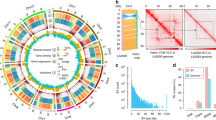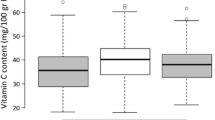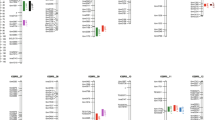Abstract
Consumption of flavonoids found in fruits and vegetables is linked to beneficial health outcomes. Tomato is among the most widely consumed and economically important vegetables worldwide and improvement of the nutrient content could lead to significant health benefits. Rutin, (quercetin-3-rutinoside), the main flavonol in tomato fruit, is confined to the peel. Rutin synthesis is limited by low expression of chalcone isomerase, the enzyme catalyzing the conversion of naringenin chalcone to naringenin quercetin. The wild tomato species Solanum habrochaites is a major source of new alleles to improve cultivated tomato (Solanum lycopersicum). AVRDC—The World Vegetable Center identified introgression line (IL) LA3984 containing a segment of S. habrochaites on chromosome 5 expressing high levels of rutin in full red ripe fruit. An AVRDC high rutin tomato line evaluated for 2 years and two seasons in Taiwan produced mean rutin content about four- to five-fold greater than the mean of all entries and about 11–12 times higher than the commercial fresh market and processing tomato cultivars. The quantitative trait locus (QTL) conditioning high rutin content was mapped to a 0.42 Mb segment on chromosome 5 flanked by markers c2_At3g55120/TaqI and ch05-4.883/ApaLI. Marker c2_Atg55120 overlaps with the chalcone-flavonone isomerase gene Solyc05g10320, and a second chalcone-flavonone isomerase gene is located 3,000 bp upstream from c2_At3g551220. Results of this project will facilitate breeding of high flavonoid tomato lines.

Similar content being viewed by others

References
Adato A, Mandel T, Mintz-Oron S, Venger I, Levy D, Yativ M, Dominguez E, Wang Z, De Vos RCH, Jetter R, Schreiber L, Heredia A, Rogachev I, Aharoni A (2009) Fruit-surface flavonoid accumulation in tomato is controlled by a SIMYB12-regulated transcriptional network. PLoS Genet 5:1–23
Bernacchi D, Beck-Bunn T, Eshed Y, Lopez J, Petiard V, Uhlig J, Zamir D, Tanksley S (1998a) Advanced backcross QTL analysis in tomato I. identification of QTLs for traits of agronomic importance from Lycoperiscon hirsutum. Theor Appl Genet 97:381–397
Bernacchi D, Beck-Bunn T, Emmaty D, Eshed Y, Inai S, Lopez J, Petiard V, Sayama H, Uhlig J, Zamir D, Tanksley S (1998b) Advanced backcross QTL analysis of tomato. II. Evaluation of near-isogenic lines carrying single-donor introgressions for desirable wild QTL-alleles derived from L. hirsutum and L. pimpinellifolium. Theor Appl Genet 97:170–180
Bovy A, de Vos R, Kemper M, Schijlen E, Almenar Pertejo M, Muir S, Collins G, Robinson S, Verhoeyen M, Highes S, Santos-Buelga C, van Tunen A (2002) High-flavonol tomatoes resulting from the heterologous expression of the maize transcription factor genes LC and C1. Plant Cell 14:2509–2526
Bovy A, Schijlen E, Hall RD (2007) Metabolic engineering of flavonoids in tomato (Solanum lycopersicum): the potential for metabolomics. Metabolomics 3:399–412
Chetelat RT (2000) TGRC stock list XII. Introgression lines. 2. L. hirsutum introgression lines. Rept Tomato Genet Coop 50:74–77
Commenges D, Scotet V, Renaud S, Jacqmin-Gadda H, Barberger-Gateau P, Dartigues JF (2000) Intake of flavonoids and risk of dementia. Eur J Epidemiol 16:357–363
Dao TTH, Linthorst HJM, Verporte R (2011) Chalcone synthase and its functions in plant resistance. Phytochem Rev 10:397–412
De Jong WS, Eannetta NT, De Jong DM, Bodis M (2004) Candidate gene analysis of anthocyanin pigmentation loci in the Solanaceae. Theor Appl Genet 108:423–432
de Leeuw PW, Bast A (2009) Tomato extract for hypertension? Editorial to The effects of natural antioxidants from tomato extract in treated but uncontrolled hypertensive patients. Cardiovasc Drugs Ther 23:107–108
Eshed Y, Zamir D (1994) A genome library of Lycopersicon pennellii in L. esculentum: a tool for finemapping genes. Euphytica 79(3):175–179
Eshed Y, Abu-Abied M, Saranga Y, Zamir D (1992) Lycopersicon esculentum lines containing small overlapping introgressions from L. pennellii. Theor Appl Genet 83:1027–1034
Frankel EN, Kanner J, German JB, Parks E, Kinsella JE (1993) Inhibition of oxidation of human low-density lipoprotein by phenolic substances in red wine. Lancet 341:454–457
Fulton TM, Chunwongse J, Tanksley SD (1995) Microprep protocol for extraction of DNA from tomato and other herbaceous plants. Plant Mol Biol Rep 13:207–209
Grandillo S, Chetelat R, Knapp S, Spooner D, Peralta I, Cammareri M, Perez O, Termolino P, Termolino P, Tripodi P, Chiusano ML, Ercolano MR, Frusciante L, Monti L, Pignone D (2011) Solanum sect. Lycopersicon. In: Cole C (ed) Wild crop relatives: genomic and breeding resources, vegetables. Springer-Verlag, Berlin, pp 129–215
Hanson PM, Yang RY, Wu J, Chen JT, Ledesma D, Tsou SCS, Lee TC (2004) Variation for antioxidant activity and antioxidants in tomato. J Amer Soc Hort Sci 129:704–711
Hanson P, Green SK, Kuo G (2006) Ty-2 gene on chromosome 11 conditioning geminivirus resistance in tomato. Tomato Genetics Coop Rep 56:17–18
Hanson P, Sitathani K, Sadashiva AT, Yang R-Y, Graham E, Ledesma D (2007) Performance of Solanum habrochaites LA1777 introgression line hybrids for marketable tomato fruit yield in Asia. Euphytica 158:167–178
Harborne JB, Williams CA (2000) Advances in flavonoid research since 1992. Phytochemistry 55:481–504
Hertog MGL, Feskens EJ, Kromhout D (1997) Antioxidant flavonols and coronary heart disease risk. Lancet 349:699
Hollman PCH, Hertog MGL, Katan MB (1996) Role of dietary flavonoids in protection against cancer and coronary heart disease. Biochem Soc Trans 24:785–789
Huxley RR, Neil HAW (2003) The relation between dietary flavonol intake and coronary heat disease mortality: a meta-analysis of prospective cohort studies. Eur J Clin Nutr 57:904–908
Ji Y, Schuster DJ, Scott JW (2007) Ty-3, a begomovirus resistance locus near the tomato yellow leaf curl virus resistance locus Ty-1 on chromosome 6 of tomato. Mol Breed 20:271–284
Jones CM, Mes P, Myers JR (2003) Characterization and inheritance of the Anthocyanin fruit (Aft) tomato. J Hered 94:449–456
Kabelka E, Yang W, Francis DM (2004) Improved fruit color within an inbred backcross line derived from Lycopersicon esculentum and L. hirsutum involves the interaction of loci. J Amer Soc Hort Sci 129:250–257
Kneckt P, Jarvinen R, Seppaanen R, Heliovaara M, Teppi L, Pukkala E, Aromaa A (1997) Dietary flavonoids and the risk of lung cancer and other malignant neoplasms. Am J Epidem 146:223–230
Le Gall G, DuPont MS, Mellon FA, Davis AL, Collins GJ, Verhoeyen ME, Colquhoun IL (2003) Characterization and content of flavonoid glycosides in genetically modified tomato (Lycopersicon esculentum) fruit. J Agric Food Chem 51:2438–2446
Levin I, Lalazar A, Bar M, Schaffer AA (2004) Non GMO fruit factories: strategies for modulating metabolic pathways in tomato fruit. Ind Crop Prod 20:29–36
Ott RL, Longnecker, M (2001). Statistical methods and data analysis. 5th ed. Wadsworth Group, Duxbury
Monforte AJ, Tanksley SD (2000a) Development of a near isogenic and backcross recombinant inbred lines containing most of the Lycopersicon hirsutum genome in a L. esculentum background: a tool for gene mapping and gene discovery. Genome 43:803–813
Monforte AJ, Tanksley SD (2000b) Fine mapping of a quantitative trait locus (QTL) from Lycopersicin hirsutum chromosome 1 affecting fruit characteristics and agronomic traits: breaking linkage among QTLs affecting different traits and dissection of heterosis for yield. Theor Appl Genet 100:471–479
Muir SR, Collins GJ, Robinson S, Hughes S, Bovy A, De Vos CHR, van Tunen AJ, Verhoeyen ME (2001) Overexpression of petunia chalcone isomerase in tomato results in fruit containing dramatically increased levels of flavonols. Nat Biotechnol 19:470–474
Peet MM (1992) Fruit cracking in tomato. HortTechnology 2:216–223
Rick CM, Cisneros P, Chetelat RT, DeVerna JW (1993) Abg–a gene on chromosome 10 for purple fruit derived from S. lycopersicoides. Rept Tomato Genet Coop 44:29–30
SAS Institute Inc. (2000) SAS OnlineDoc®, Version 8. Cary, NC
Schijlen EGWM, de Vos CHR, Martens S, Jonker HN, Rosin FM, Molthoff JW, Tikunov YM, Angenent GC, van Tunen AJ, Bovy AG (2007) RNAi silencing of chalcone synthase, the first step in the flavonoid biosynthesis pathway, leads to parthenocarpic tomato fruits. Plant Physiol 144:1520–1530
Sheskin D (2004) Handbook of parametric and nonparametric statistical procedures. 3rd ed. Chapman and Hall/CRC
Simonetti P, Gardana C, Riso P, Mauri P, Pietta P, Porinni M (2005) Glycosylated flavonoids from tomato puree are bioavailable in humans. Nutr Res 25:717–726
Sol Genomics Network (2013) http://solgenomics.net/. Accessed Nov. 28 2013
Stewart AJ, Bozonnet S, Mullen W, Jenkins GI, Lean ME, Crozier A (2000) Occurrence of flavonols in tomatoes and tomato-based products. J Agric Food Chem 48:2663–2669
Stommel JR, Haynes KG (1993) Genetic control of fruit sugar accumulation in a Lycopersicon esculentum × L. hirsutum cross. J Amer Soc Hort Sci 118:859–863
Tanksley SD, Nelson JC (1996) Advanced backcross QTL analysis: a method for the simultaneous discovery and transfer of valuable QTLs from unadapted germplasm into elite breeding lines. Theor Appl Genet 92:191–203
The Tomato Genome Consortium (2012) The tomato genome sequence provides insights into fleshy fruit evolution. Nature 485:635–641
Tomes ML, Quakenbush FW, McQuistan M (1954) Modification and dominance of the gene governing formation of high concentrations of beta-carotene in the tomato. Genetics 39:810–817
Vauzour D, Vafeiadou K, Rodriguez-Mateos A, Rendeiro C, Spencer JPE (2008) The neuroprotective potential of flavonoids: a multiplicity of effects. Genes Nutr 3:115–126
Verhoeyen ME, Bovy A, Collins G, Muir S, Robinson S, de Vos CHR, Colliver S (2002) Increasing antioxidant levels in tomatoes through modification of the flavonoid biosynthetic pathway. J Exp Bot 53:2099–2106
Wann EV (1997) Tomato germplasm lines T4065, T4099, T5019, and T5020 with unique genotypes that enhance fruit quality. HortScience 32:747–748
Willits MG, Kramer CM, Prata RTN, De Luca V, Potter BG, Steffens JC, Graser G (2005) Utilization of the genetic resources of wild tomato species to create a nontransgenic high flavonoid tomato. J Agric Food Chem 53:1231–1236
Winkel-Shirley B (2002) Biosynthesis of flavonoids and effects of stress. Curr Opin Plant Biol 5:218–223
Yao LH, Jiang YM, Shi J, Tomás-Barberán FA, Datta N, Singanusong R, Chen SS (2004) Flavonoids in food and their health benefits. Plant Foods Hum Nutr 59:113–122
Zamir D (2001) Improving plant breeding with exotic genetic libraries. Nat Rev Genet 2:983–989
Acknowledgments
The authors thank Maureen Mecozzi for editing the manuscript and the CM Rick Tomato Genetics Resources Center at the University of California-Davis for providing seeds of the introgression lines. Financial support from the Federal Ministry for Economic Cooperation and Development, Germany, project number 03.7860.4–001.00 is gratefully acknowledged.
Author information
Authors and Affiliations
Corresponding author
Rights and permissions
About this article
Cite this article
Hanson, P., Schafleitner, R., Huang, SM. et al. Characterization and mapping of a QTL derived from Solanum habrochaites associated with elevated rutin content (quercetin-3-rutinoside) in tomato. Euphytica 200, 441–454 (2014). https://doi.org/10.1007/s10681-014-1180-7
Received:
Accepted:
Published:
Issue Date:
DOI: https://doi.org/10.1007/s10681-014-1180-7



